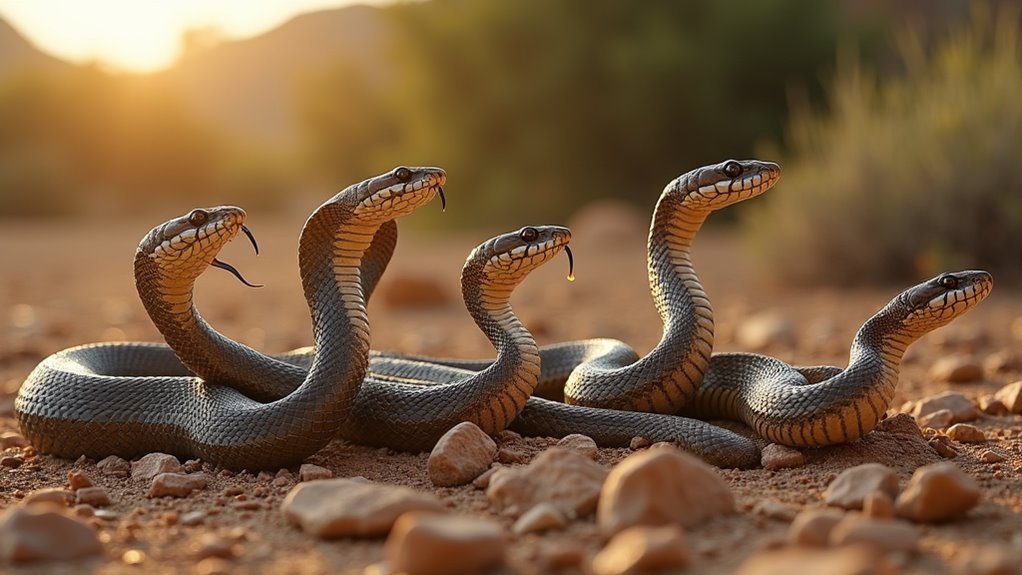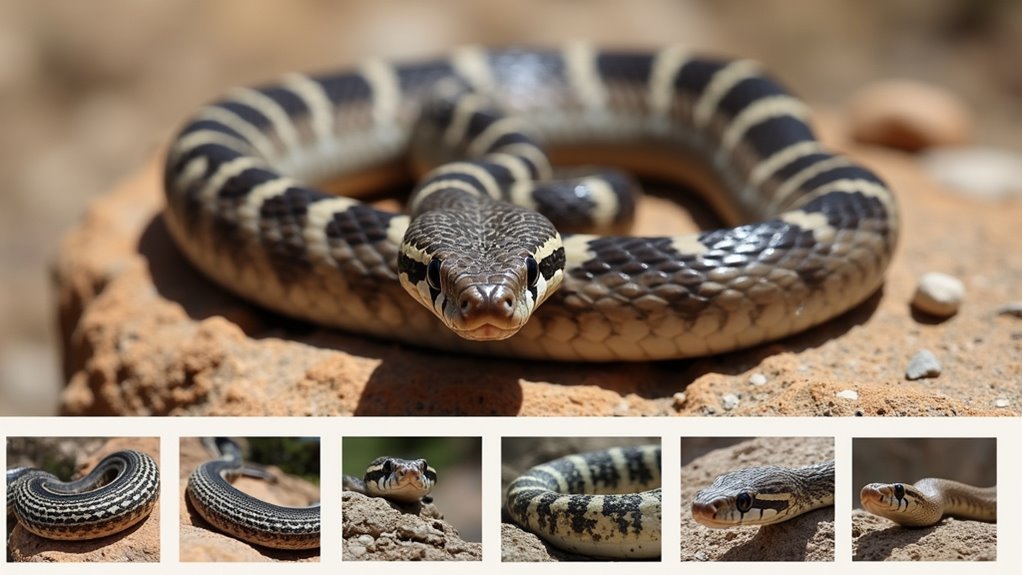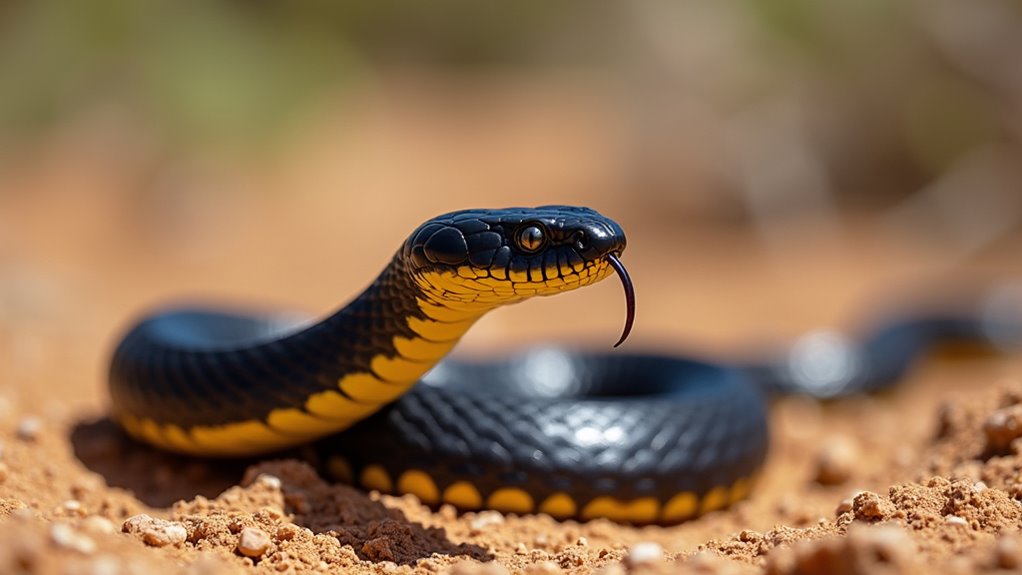Physical Address
304 North Cardinal St.
Dorchester Center, MA 02124
Physical Address
304 North Cardinal St.
Dorchester Center, MA 02124

In Spain's diverse landscapes lurk five deadly serpents whose venom can cause severe harm or death.
Spain’s most venomous snakes include the Asp Viper, with its potent hemotoxic venom and distinctive zigzag pattern, and Lataste’s Viper, recognizable by its “horned” snout. The Montpellier Snake, though mildly venomous, poses risk due to its common presence in agricultural areas. The Pyrenean Viper delivers dangerous hemotoxic venom at high altitudes, while Seoane’s Viper inhabits northern Spain’s humid regions. Understanding these species’ habitats and behaviors can help you avoid dangerous encounters.

These vipers reach 65cm in length and display distinctive zigzag dorsal stripes with orange or grey coloration. They prefer sunny slopes, scrublands, and limestone-rich areas with dry soils and good cover. The subspecies in northeastern Spain can be found at high altitudes exceeding 2,100 meters in the Pyrenees.
Though the fatality rate is under 1% with prompt treatment, their venom contains potent procoagulants and hemorrhagic compounds that cause intense pain, swelling, and potentially tissue necrosis. The Asp Viper is considered the most dangerous snake in Spain due to its potent venom and relatively wide distribution.
While listed as “Least Concern” globally, their populations are declining due to habitat fragmentation and persecution.
While the Asp Viper claims the title of Spain’s deadliest serpent, Lataste’s Viper presents another venomous threat worth recognizing. You’ll identify this distinctive snake by the unique “horn” on its snout, triangular head, grey body with zig-zag pattern, and yellow tail tip that lures unsuspecting prey.
This venomous species inhabits various environments across southwestern Europe and northwestern Africa, including:
Though not as potent as some vipers, its venom remains dangerous. You’ll rarely encounter attacks, as these snakes typically avoid humans unless provoked. Unlike many creatures of the shore, these vipers are not found in snorkeling spots along the Spanish coast. The scientific name Vipera latastei honors Fernand Lataste, a French herpetologist who was a colleague of the scientist who named the species. Still, exercise caution when exploring their habitats, especially when they might be hidden under rocks.

Among Spain’s venomous serpents, the Montpellier snake is notable as both common and relatively mild. You’ll find this impressive snake—which can grow up to 2 meters long—throughout most of Spain, except for the northern Atlantic regions.
While venomous, its rear-fanged delivery system and low-toxicity venom make it minimally dangerous to humans. If bitten, you’ll likely experience only pain and swelling rather than life-threatening symptoms. In severe cases, patients may develop neurological signs like ptosis, difficulty swallowing, and dyspnea, though full recovery without long-term complications is the norm.
Despite being venomous, its inefficient fangs and mild toxins mean bites rarely cause more than local discomfort.
The Montpellier snake typically prefers agricultural areas and bushy wastelands, increasing the likelihood of human encounters. Unlike in the Geneva region where various mountain habitats provide different snake ecosystems, Spain’s landscape offers ideal conditions for this species. Though it usually flees when spotting humans, it may bite if cornered or handled.
Field herpetologists face the highest risk due to their direct handling of these snakes, but for most people, they pose little danger.
Hidden throughout Spain’s Pyrenean mountain ranges lurks the formidable Pyrenean viper (Vipera aspis zinnikeri), one of the country’s most dangerous venomous snakes. This powerful reptile thrives in the rocky, sun-exposed terrain spanning northeastern Spain and southwestern France, reaching altitudes over 2,100 meters. The snake’s dorsal pattern features a broad wavy stripe with contrasting light edges that helps it blend into its mountainous surroundings.
If you’re hiking in the Pyrenees, watch for these key characteristics:
Despite their dangerous reputation, these vipers typically avoid human contact and remain in isolated mountain habitats. Unlike the vibrant nightlife in Albufeira, where people actively seek entertainment, encounters with these snakes are rare and usually accidental.

Nestled throughout the northern regions of Spain, the Seoane’s viper (Vipera seoanei) guards its Atlantic-climate territories from Galicia to the Cantabrian Mountains. You’ll find this venomous snake from sea level up to 1900 meters in elevation, thriving in humid environments including temperate forests, scrublands, and agricultural areas. Similar to the unique coastal landscapes of Split, these diverse habitats provide ideal conditions for this distinctive reptile species.
Along Spain’s northern coast, the venomous Seoane’s viper claims territory from misty Galician forests to rugged Cantabrian peaks.
The species features two main subspecies: V. s. seoanei and V. s. cantabrica, with the latter specifically inhabiting the south central Cantabrian Mountains. This fascinating viper exhibits high polymorphism with four distinct color patterns ranging from zigzag markings to uniform brownish morphs.
As an ovoviviparous species, it keeps its developing young protected inside the mother before birth—an adaptation well-suited to cooler Atlantic climates.
Despite its venomous nature, Seoane’s viper maintains a “Least Concern” conservation status, with stable populations across its range and protection under the Berne Convention.
Spain’s venomous serpents serve as nature’s warning signs—their distinctive patterns like caution tape across the landscape. You’ll now recognize these five slithering dangers whether hiking mountain trails or exploring coastal regions. Remember, they’re not villains but essential ecosystem guardians. Give them space, wear proper footwear, and keep a watchful eye. Your wilderness adventures can continue safely when you respect these powerful symbols of Spain’s wild heritage.